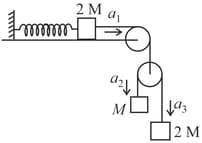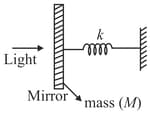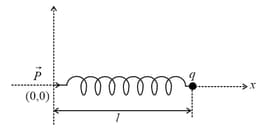Embibe Experts Solutions for Chapter: Oscillations, Exercise 1: JEE Advanced Paper 2 - 2019
Embibe Experts Physics Solutions for Exercise - Embibe Experts Solutions for Chapter: Oscillations, Exercise 1: JEE Advanced Paper 2 - 2019
Attempt the practice questions on Chapter 8: Oscillations, Exercise 1: JEE Advanced Paper 2 - 2019 with hints and solutions to strengthen your understanding. EMBIBE CHAPTER WISE PREVIOUS YEAR PAPERS FOR PHYSICS solutions are prepared by Experienced Embibe Experts.
Questions from Embibe Experts Solutions for Chapter: Oscillations, Exercise 1: JEE Advanced Paper 2 - 2019 with Hints & Solutions
A block of mass is attached to a massless spring with spring-constant This block is connected to two other blocks of masses and using two massless pulleys and strings. The accelerations of the blocks are and as shown in figure. The system is released from rest with the spring in its unstretched state. The maximum extension of the spring is Which of the following option(s) is/are correct?
[ is the acceleration due to gravity. Neglect friction]

A perfectly reflecting mirror of mass mounted on a spring constitutes a spring-mass system of angular frequency such that with as Planck's constant. photons of wavelength strike the mirror simultaneously at normal incidence such that the mirror gets displaced by If the value of is then the value of is________.
[Consider the spring as massless]

A block with mass is connected by a massless spring with stiffness constant to a rigid wall and moves without friction on a horizontal surface. The block oscillates with small amplitude about an equilibrium position . Consider two cases : (i) when the block is at and (ii) when the block is at . In both the cases, a particle with mass is softly placed on the block after which they stick to each other. Which of the following statement(s) is(are) true about the motion after the mass is placed on the mass ?
A particle of mass is attached to one end of a massless spring of force constant , lying on a frictionless horizontal plane. The other end of the spring is fixed. The particle starts moving horizontally from its equilibrium position at time with an initial velocity . When the speed of the particle is , it collides elastically with a rigid wall. After this collision :
One end of a spring of negligible unstretched length and spring constant is fixed at the origin . A point particle of mass carrying a positive charge is attached at its other end. The entire system is kept on a smooth horizontal surface. When a point dipole pointing towards the charge is fixed at the origin, the spring gets stretched to a length and attains a new equilibrium position (see figure below). If the point mass is now displaced slightly by from its equilibrium position and released, it is found to oscillate at frequency The value of is _______.

Two independent harmonic oscillators of equal mass are oscillating about the origin with angular frequencies and and have total energies and , respectively. The variations of their momenta with positions are shown in the figures. If and , then the correct equation(s) is (are)

